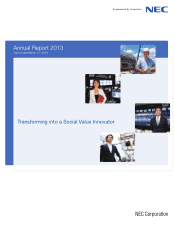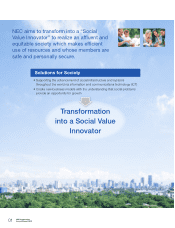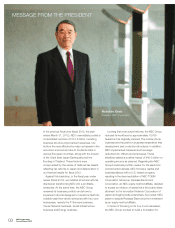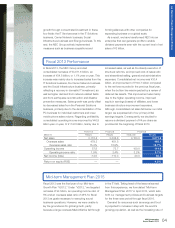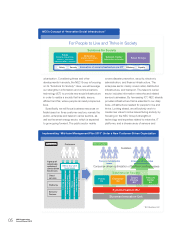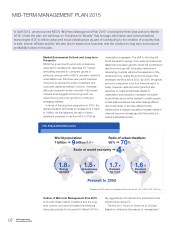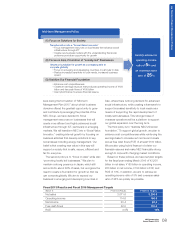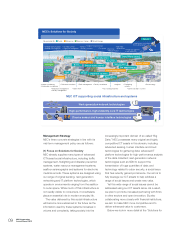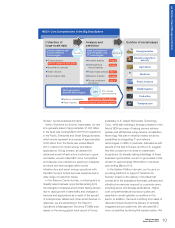NEC 2013 Annual Report Download - page 8
Download and view the complete annual report
Please find page 8 of the 2013 NEC annual report below. You can navigate through the pages in the report by either clicking on the pages listed below, or by using the keyword search tool below to find specific information within the annual report.
The Future World Economy
In April 2013, we announced NEC’s “Mid-term Management Plan 2015” covering the three-year period to March
2016.Undertheplan,wewillfocuson“SolutionsforSociety”thatleverageinformationandcommunications
technologies (ICT) to deliver advanced social infrastructure as part of contributing to the creation of a society that
is safe, secure, efficient and fair. We also aim to expand our business over the medium to long term and improve
profitability based on the plan.
Energy
demand
World population:
7 billion ➡ 9 billion (1.3 x)
Scale of world economy ➡ 4x
Ratio of urban dwellers:
50% ➡ 70%
1.8 x
Greenhouse
gases
1.5 x
Demand
for food
1.7 x
Demand
for water
1.6 x
MID-TERM MANAGEMENT PLAN 2015
Market Environment Outlook and Long-term
Prospects
Whilst the government’s economic policies are
expected to revitalize the Japanese ICT market,
stimulating demand for consumer goods in
particular, slow growth in NEC’s domestic market is
unavoidable over this three-year period because
more time is required for public investment and
corporate capital spending to recover. Overseas,
although prospects remain uncertain in European
markets amid sluggish economic growth, we
expect strong economic growth to continue in
emerging markets.
In terms of the long-term perspective to 2050, the
global population is forecast to increase from 7 billion
to 9 billion. As this happens, the ratio of urban
dwellers is projected to rise from 50% to 70% as
Outline of Mid-term Management Plan 2015
In line with these market conditions and the long-
term outlook, we have formulated the following
three plan policies for the period to March 2016 to
urbanization progresses. The shift to city living will
boost demand for energy, food, water and resources
faster than population growth, which will contribute to
rapid economic growth. Emerging markets and
developing countries will drive the expansion of the
world economy, rivaling the economic scale of the
developed world by about 2032. By 2050, the global
economy is expected to be four times the size it is
today. However, rapid economic growth is also
expected to create social issues related to
urbanization and population increases. Innovative
social infrastructure will be needed to enable people
to lead safe and secure lives while making efficient
use of resources. In this way, efficient social
infrastructure to sustain population increase mainly in
cities will become increasingly vital if humanity is to
build a sustainable society.
tap aggressively into demand for advanced social
infrastructure using ICT.
The first is to “focus on Solutions for Society.”
Based on extensive discussions at management
(*PreparedbyNECbasedonmaterialspublishedbytheUN,FAO,OECD,PWC,IMF,etc.)
Present to 2050
07 NEC Corporation
Annual Report 2013

